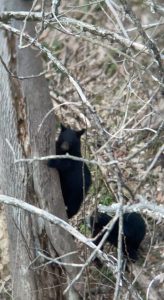Second in a series by White River Steward Grace van Kan. In part 1, Grace described the dramatic first sighting of black bears. The story continues…
The next day we were due to meet with bear biologist David Whitehead, a curator at Appalachian Bear Rescue (ABR). Rehabilitating their first bear in 1996, ABR is an organization that rescues and rehabilitates orphaned and injured black bears. David is a wealth of knowledge and experience, sharing the history of black bears in the park and neighboring states. He also provided what I found to be a very enlightening lesson on bear biology.
One surprising thing that stood out to me is that bears do not hibernate all winter, rather, they enter torpor for weeks at a time. During torpor, body temperature and metabolism are lowered in order to reduce energy expenditure. Male black bears may not den at all during this time, but mother bears will always den, though not in the same one each year.
Cubs are born during winter hibernation at a whopping eight ounces, providing for an easy low-cal birth. (The birth doesn’t require much energy at all from the mother. She might even be asleep!)

Bear cubs are able to climb trees almost immediately, with claws meant more for digging and climbing than for hunting.
Black bears are omnivorous, and in the park they mostly feed on hard mast, meaning nuts. Oak acorns, hickory nuts, and beech nuts are critical for survival as they promote weight gain and growth.
With enough mast, a single bear can gain 150 pounds per month for the winter. The diet of bears in the park is likely less than 5% meat, most of which is carrion. Females in the park average 150 pounds, while males average 250 pounds.
After the lesson, complete with interactive supplements such as black bear claws, fur, and canine teeth (recovered humanely from deceased bears), David made a quick call to ABR and the second part of our black bear experience ensued!
Here is a short video of young bears climbing, seen from the porch of our lodging.
Next up: Grace visits the Appalachian Bear Rescue facility. Find out more about her Great Smoky Mountains studies in our summer newsmagazine story, “River Deep, Mountain High.”

Grace van Kan
White River Steward